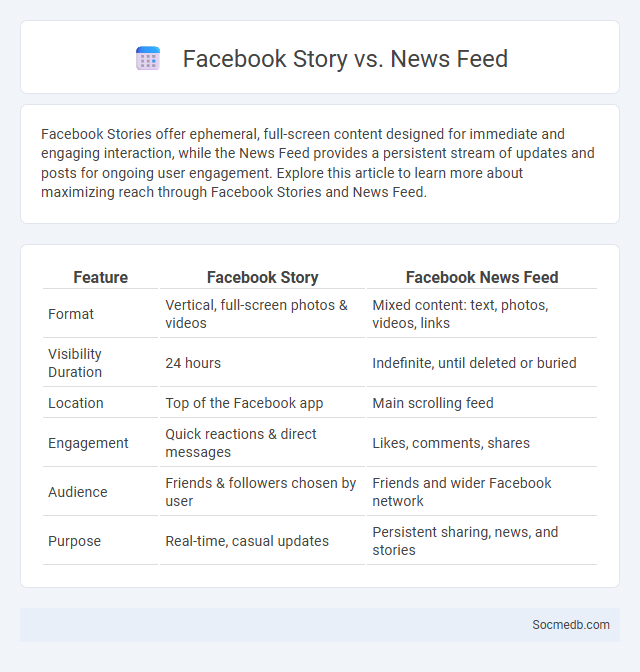
Photo illustration: Facebook Story vs News Feed
Facebook Stories offer ephemeral, full-screen content designed for immediate and engaging interaction, while the News Feed provides a persistent stream of updates and posts for ongoing user engagement. Explore this article to learn more about maximizing reach through Facebook Stories and News Feed.
Table of Comparison
| Feature | Facebook Story | Facebook News Feed |
|---|---|---|
| Format | Vertical, full-screen photos & videos | Mixed content: text, photos, videos, links |
| Visibility Duration | 24 hours | Indefinite, until deleted or buried |
| Location | Top of the Facebook app | Main scrolling feed |
| Engagement | Quick reactions & direct messages | Likes, comments, shares |
| Audience | Friends & followers chosen by user | Friends and wider Facebook network |
| Purpose | Real-time, casual updates | Persistent sharing, news, and stories |
Introduction to Facebook Story and News Feed
Facebook Story allows users to share ephemeral multimedia content that disappears after 24 hours, enhancing real-time social engagement and personal expression. The News Feed aggregates posts, photos, videos, and advertisements from friends, pages, and groups tailored by Facebook's algorithm to optimize user interaction and content relevance. Together, these features drive dynamic user experiences by combining transient storytelling with continuous social updates.
What is Facebook Story?
Facebook Story is a feature that allows you to share photos and short videos that disappear after 24 hours, providing a quick way to update friends and followers. These stories appear at the top of the Facebook app, enhancing visibility and engagement with your content in a fleeting, authentic format. Your audience can interact with your Facebook Story through reactions and messages, fostering real-time connection.
What is Facebook News Feed?
Facebook News Feed is the continuously updated stream of posts, photos, videos, and links shared by your friends, pages you follow, and groups you join. This algorithm-driven feature prioritizes content based on your interactions, relevance, and timeliness to provide a personalized browsing experience. Understanding how the News Feed works helps you control what appears and engage more effectively with your social media community.
Key Differences Between Facebook Story and News Feed
Facebook Stories offer ephemeral content that disappears after 24 hours, enhancing real-time, casual sharing with interactive features like stickers and polls. The News Feed provides permanent posts visible to friends and followers, optimized for engagement through likes, comments, and shares on a variety of content types including text, photos, and videos. Stories prioritize immediacy and visual storytelling, while News Feed emphasizes long-lasting user interaction and content discovery.
Visual Content: Stories vs Feed Posts
Visual content on social media significantly impacts engagement, with Stories offering ephemeral, interactive experiences and Feed Posts providing lasting, polished visuals. Stories enhance real-time connection through features like polls, stickers, and direct replies, making your audience feel involved and valued. Feed Posts build a cohesive brand aesthetic and serve as a permanent showcase of your best content, reinforcing brand identity over time.
Audience Reach and Engagement Comparison
Social media platforms vary significantly in audience reach and engagement, with Facebook boasting over 2.9 billion monthly active users, making it ideal for broad audience targeting, while Instagram excels in visual content engagement, especially among younger demographics. Twitter offers real-time interaction and trending topic participation, but its user base is smaller, around 450 million monthly active users, resulting in different engagement dynamics. Understanding these distinctions helps you tailor your social media strategy to maximize impact and connect effectively with your desired audience.
Duration and Visibility: Stories vs Feed
Stories on social media platforms like Instagram and Facebook typically last 24 hours, offering temporary visibility that encourages quick engagement. Feed posts provide longer-lasting exposure, remaining visible indefinitely unless deleted, making them ideal for sustained audience reach. The choice between stories and feed posts hinges on the desired balance between short-term impact and long-term presence.
Best Use Cases for Facebook Story
Facebook Stories provide an ideal platform for sharing real-time updates, behind-the-scenes content, and limited-time promotions that captivate your audience quickly. Brands benefit from enhanced engagement by leveraging interactive features like polls, questions, and swipe-up links to drive direct responses. Your marketing strategy can maximize visibility and personal connection by utilizing Facebook Story's ephemeral nature to create urgency and exclusivity.
When to Use News Feed Posts
News feed posts are ideal when you want to reach a broad audience with timely updates, engage users through visually appealing content, or promote special offers and events. Using these posts strategically increases visibility and interaction by appearing directly in your followers' main social media streams. You can boost your brand awareness and drive traffic by consistently sharing relevant news feed content during peak user activity times.
Which Format Is Best for Your Goals?
Choosing the best social media format depends on your specific goals, such as brand awareness, engagement, or conversions. Video content often drives higher engagement and brand recall, while images and infographics excel at quick information sharing and boosting visual appeal. For direct conversions and lead generation, carousel ads and interactive stories on platforms like Instagram and Facebook offer targeted and measurable results.
 socmedb.com
socmedb.com